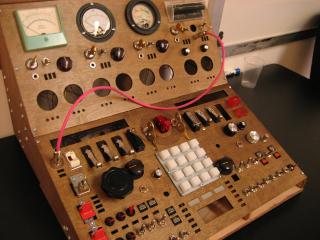Anh Nguyen
Happy Feedback Machine
The Happy Feedback Machine is a button and switch interface that creates and fulfills a user\'s desire to push and play with its many buttons, switches, knobs and parts.
http://itp.nyu.edu/~ttn206/haptic

The Happy Feedback Machine is a button and switch interface that allows users to attain tactile satisfaction from exploring its many components. It is a time-travel device for children and adults with hidden sequences of switch and button combinations that unlocks secret functionalities. The machine also serves therapeutic purposes.
Regardless of age, gender, ethnicity or background, humans naturally want to touch buttons when presented with one. What compels us to touch these buttons and why do we derive so much satisfaction from doing so? The Happy Feedback Machine explores these questions in a fun and engaging manner.
- Human computer interaction
- Interface design
- Analog music recording interfaces
- Airplane cockpits
- Dr. Who gadgets
- Tactile responses
- Children 3 and up
- Adults and people attracted to strange looking gadgets
- Anyone who likes pushing buttons and the haptic feedback from doing so
A user sees the Haptic Feedback Machine and is intrigued by its physical presence. They approach the machine and wonder what all the inticing buttons and switches do. As they explore the buttons and switches, sounds and lights become activated. The longer they play with the machine, they begin to realize that their is logic behind all the madness and that their are hidden combinations of button switches and power combinations that produce special effects.
Constructed from Birch wood and 100 + indusitrial switches, buttons, knobs, meters and various haptic devices.
There are different units to the machine which recieve power from 1/4\" jacks that the user has to plug in.
The main purpose of the device is to allow users to play with the many buttons and switches and thus derive haptic pleasure from doing so.
From the small scale, cardboard prototype I created, I\'ve learned that people are naturally attracted to the machine. Seeing the many buttons and switches is very appealing and people naturally want to touch and play with the buttons. When they do push the buttons, users find a lot of tactile satisfaction.
Regardless of age, gender, ethnicity or background, humans naturally want to touch buttons when presented with one. What compels us to touch these buttons and why do we derive so much satisfaction from doing so? The Happy Feedback Machine explores these questions in a fun and engaging manner.
- Human computer interaction
- Interface design
- Analog music recording interfaces
- Airplane cockpits
- Dr. Who gadgets
- Tactile responses
- Children 3 and up
- Adults and people attracted to strange looking gadgets
- Anyone who likes pushing buttons and the haptic feedback from doing so
A user sees the Haptic Feedback Machine and is intrigued by its physical presence. They approach the machine and wonder what all the inticing buttons and switches do. As they explore the buttons and switches, sounds and lights become activated. The longer they play with the machine, they begin to realize that their is logic behind all the madness and that their are hidden combinations of button switches and power combinations that produce special effects.
Constructed from Birch wood and 100 + indusitrial switches, buttons, knobs, meters and various haptic devices.
There are different units to the machine which recieve power from 1/4\" jacks that the user has to plug in.
The main purpose of the device is to allow users to play with the many buttons and switches and thus derive haptic pleasure from doing so.
From the small scale, cardboard prototype I created, I\'ve learned that people are naturally attracted to the machine. Seeing the many buttons and switches is very appealing and people naturally want to touch and play with the buttons. When they do push the buttons, users find a lot of tactile satisfaction.
